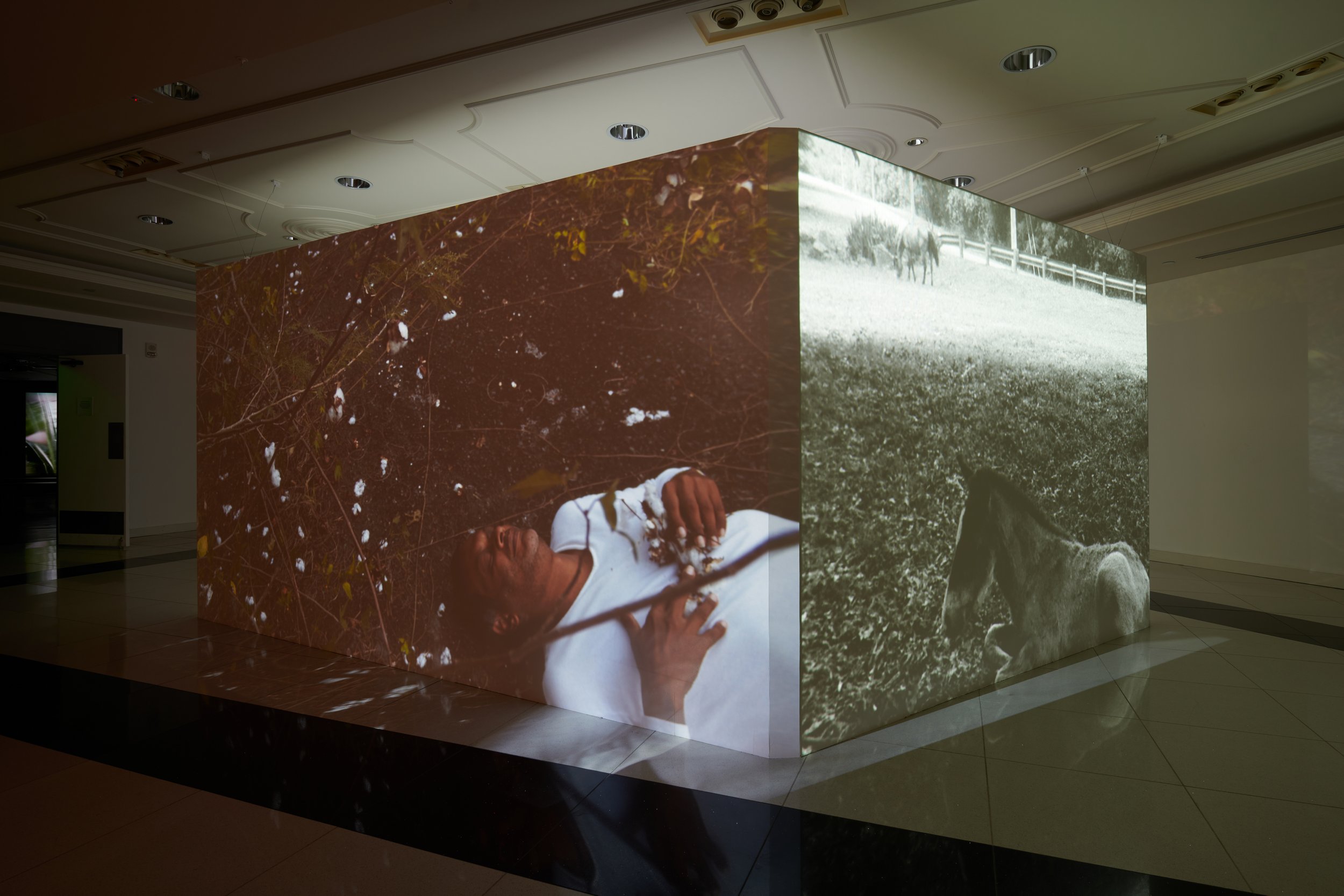Beatriz Santiago Muñoz
b. 1972, San Juan, Puerto Rico
lives and works in San Juan and Annandale-on-Hudson, New York
hawai‘i triennial 2022
@ ROYAL HAWAIIAN CENTER
» » Hear more about Beatriz Santiago Muñoz’s work in the Hawai‘i Loves Puerto Rico: Beatriz Santiago Muñoz episode of fresh pacific, a podcast with award-winning journalist Noe Tanigawa.
Installation views: Beatriz Santiago Muñoz, Ojos para mis enemigos, 2014, HD video, sound, 14 mins, 14 secs; Post-Military Cinema, 2014, HD video, sound, 11 mins; Black Beach/Horse/Camp/The Dead/Forces, 2016, digital black and white video transferred from 16 mm black and white film, silent, 8 mins; Otros Usos, 2014, digital color video transferred from 16 mm color film, sound, 7 mins; Royal Hawaiian Center, HT22, Honolulu. Courtesy of the artist and Hawai‘i Contemporary. Photos: Christopher Rohrer.
Beatriz Santiago Muñoz is an artist and educator working at the intersections of documentary practice and engaged activism. Navigating the space formed by aesthetic concerns, desires for truth, and senses of place, Santiago Muñoz utilizes the camera to blur presumed boundaries between fact and fiction. Through collaborative, improvisational, performative, poetic, and sensory works, she challenges regimes of (in)visibility, imagines alternative modes of representation, and explores the possibilities of a decolonized Caribbean.
In the mid-2010s, conscious of the ways Puerto Rico has been impacted by the U.S. military since the early 1920s, Santiago Muñoz produced a series of short films shot on former military installations in Ceiba and the nearby island municipality of Vieques. Following a protracted political battle led by progressive and pro-independence groups to stop the U.S. Navy’s bombing of Vieques, the U.S. government closed Marine Corps Base Camp Garcia on May 1, 2003. Less than a year later, on March 31, 2004, Roosevelt Roads U.S. Naval Station in Ceiba followed suit, marking the end of over half a century of use by the navy for target practice and to service its Atlantic Fleet. If displacement characterized the U.S. military’s arrival in the islands, their legacy is environmental contamination, with Vieques declared a Superfund site by the Environmental Protection Agency in 2005.
Despite this toxic hangover, Santiago Muñoz’s depictions of Vieques in the films Otros Usos (2014) and Black Beach/Horse/Camp/The Dead/Forces (2016), and Ceiba in the videos Ojos para mis enemigos (2014) and Post-Military Cinema (2014), are teeming with life. These four works comprise her contribution to HT22. Otros Usos offers kaleidoscope-like views of people and place, shot from a nearly two-and-a-half-kilometer-long structure previously used to service battleships and presently used by fishermen. Black Beach silently weaves together land, bombs, political work, celebration, and death as cosmic balance is slowly restored to the island. Ojos para mis enemigos observes how multiple introduced and Indigenous species—plants and crops, but also animals and humans—share terrain and together constitute a new space of devastation and recuperation. Post-Military Cinema makes visible and audible a decommissioned military cinema where images of the thriving forest are projected daily by the afternoon light.
In the context of frenetic Waikīkī, an epicenter of tourism in the Pacific, and bracketed by Fort DeRussy and the former Fort Ruger, Santiago Muñoz’s films and videos help establish visual and auditory connections between two archipelagic nations over 9,000 kilometers apart. Speaking to the importance of listening carefully to place, and not just looking at it, Santiago Muñoz has said of the sounds of the closed bases, ‘there were iguanas eating bird and frog eggs; there were hundreds of different kinds of insects; packs of abandoned dogs...; fishermen sleeping in cars;...beehives above the ceiling tiles; a few wild boars, at least one caiman in the old reservoir system; a forest of large almácigos where locals say a toxic spill [once occurred]; and bats in all the barracks.’ Within this cacophony of entangled expressions, the potential of energetic transformation and revitalized futures—however enigmatic they may be—are already in the making.







